Effects of Laminar, Turbulent, and Slip Conditions in a Fluid Film on a Dry Gas Seal
Abstract
1. Introduction
2. Method of Analysis
2.1. Governing Equations According to Laminar, Turbulent and Slip Conditions of Fluid Film
2.2. Derivation of a Finite-Element Equation
3. Numerical Verification
3.1. Verification of the Turbulent Condition of the Developed Program with Prior Research
3.2. Verification of Slip Conditions of the Developed Program Using Prior Research
4. Experimental Verification
5. Effect of Laminar, Turbulent, and Slip Conditions of a Fluid Film on a Dry Gas Seal
5.1. Pressure of the Fluid Film in a Dry Gas Seal Due to Laminar, Turbulent, and Slip Conditions of Fluid Film
5.2. Opening Force of the Fluid Film in a Dry Gas Seal Due to Laminar, Turbulent and Slip Conditions of Fluid Film
5.3. Leakage Rate of a Fluid Film of a Dry Gas Seal Due to Laminar, Turbulent, and Slip Conditions of a Fluid Film
6. Conclusions
Author Contributions
Funding
Data Availability Statement
Acknowledgments
Conflicts of Interest
Nomenclature
| Turbulent coefficient for radial flow; | |
| Turbulent coefficient for circumferential flow; | |
| Film thickness [mm] | |
| Knudsen number | |
| Shape function vector | |
| Element pressure vector [Pa] | |
| Pressure [Pa] | |
| Flow rate for laminar flow [g/s] | |
| Flow rate for slip flow [g/s] | |
| Flow rate for turbulent flow [g/s] | |
| Slip coefficient; | |
| Reynolds number | |
| Gas constant [J/(kg·K)] (: 287 J/(kg·K)) | |
| Temperature [K] | |
| Rotating velocity [rad/s] | |
| Fluid velocity [m/s] | |
| weighting function | |
| Greek symbols | |
| Density [kg/m3] | |
| arbitrary vector | |
| Viscosity [Pa∙s] |
References
- Yan, W.; Jianjun, S.; Qiong, H.; Da, W.; Xiaoqing, Z. Orientation effect of orderly roughness microstructure on spiral groove dry gas seal. Tribol. Int. 2018, 126, 97–105. [Google Scholar] [CrossRef]
- Jiang, J.; Peng, X.; Zong, C.; Zhao, W.; Chen, Y.; Li, J. Enhancing Film Stiffness of Spiral Groove Dry Gas Seal via Shape Modification at Low Speed: Numerical Results and Experiment. Tribol. Trans. 2019, 62, 931–942. [Google Scholar] [CrossRef]
- Kou, G.; Li, X.; Wang, Y.; Lin, M.; Tan, C.; Mou, M. Steady performance and dynamic characteristics of a superellipse groove dry gas seal at a high-speed condition. Ind. Lubr. Tribol. 2020, 72, 789–796. [Google Scholar] [CrossRef]
- Gabriel, R.P. Fundamentals of spiral groove noncontacting face seals. Lubr. Eng. 1979, 35, 367–375. [Google Scholar]
- Blasiak, S.; Zahorulko, A.V. A parametric and dynamic analysis of non-contacting gas face seals with modified surfaces. Tribol. Int. 2016, 94, 126–137. [Google Scholar] [CrossRef]
- Chen, Y.; Peng, X.; Jiang, J.; Meng, X.; Li, J. Experimental and theoretical studies of the dynamic behavior of a spiral-groove dry gas seal at high-speeds. Tribol. Int. 2018, 125, 17–26. [Google Scholar] [CrossRef]
- Zhu, D.; Bai, S. Ultra-high-speed TEHL characteristics of T-groove face seal under supercritical CO2 condition. Ind. Lubr. Tribol. 2021, 73, 523–530. [Google Scholar] [CrossRef]
- Luo, J.; Brillert, D. Experimental Investigations on the Pressure Fluctuations in the Sealing Gap of Dry Gas Seals With Embedded Pressure Sensors. J. Eng. Gas Turbines Power 2021, 143, 031005. [Google Scholar] [CrossRef]
- Zhang, C.; Jiang, J.-B.; Peng, X.-D.; Meng, X.-K.; Li, J.-Y. The influence and a direct judgement method of the flow state in supercritical CO2 dry gas seal. J. Braz. Soc. Mech. Sci. Eng. 2021, 43, 486. [Google Scholar] [CrossRef]
- Yan, R.; Chen, H.; Zhang, W.; Hong, X.; Bao, X.; Ding, X. Calculation and verification of flow field in supercritical carbon dioxide dry gas seal based on turbulent adiabatic flow model. Tribol. Int. 2022, 165, 107275. [Google Scholar] [CrossRef]
- Ruan, B. Finite Element Analysis of the Spiral Groove Gas Face Seal at the Slow Speed and the Low Pressure Conditions—Slip Flow Consideration. Tribol. Trans. 2000, 43, 411–418. [Google Scholar] [CrossRef]
- Ding, X.; Lu, J. Theoretical analysis and experiment on gas film temperature in a spiral groove dry gas seal under high speed and pressure. Int. J. Heat Mass Transf. 2016, 96, 438–450. [Google Scholar] [CrossRef]
- Ng, C.-W.; Pan, C.H.T. A Linearized Turbulent Lubrication Theory. J. Basic Eng. 1965, 87, 675–682. [Google Scholar] [CrossRef]
- Taylor, C.M.; Dowson, D. Turbulent Lubrication Theory—Application to Design. J. Lubr. Technol. 1974, 96, 36–46. [Google Scholar] [CrossRef]
- Beskok, A.; Karniadakis, G.E.; Trimmer, W. Rarefaction and compressibility effects in gas microflows. J. Fluids Eng. 1996, 118, 448–456. [Google Scholar] [CrossRef]
- Lu, J.; Ding, X.; Zhang, W. The influence of spiral angle on lift-off speed of face gas seal under start-up. SN Appl. Sci. 2019, 1, 1068. [Google Scholar] [CrossRef]
- S.Fukui, R.K. Analysis of Ultra-Thin Gas Film Lubrication Based on Linearized Boltzmann Equation: First Report—Derivation of a Generalized Lubrication Equation Including Thermal Creep Flow. J. Tribol. 1988, 110, 253. [Google Scholar] [CrossRef]
- S.Fukui, R.K. A database for interpolation of poiseuille flow rates for high knudsen number lubrication problems. J. Tribol. 1990, 112, 78–83. [Google Scholar] [CrossRef]
- Faria, M.T.C. An Efficient Finite Element Procedure for Analysis of High-Speed Spiral Groove Gas Face Seals. J. Tribol. 2001, 123, 205–210. [Google Scholar] [CrossRef]
- Wang, B.; Zhang, H.; Cao, H. Flow dynamics of a spiral-groove dry-gas seal. Chin. J. Mech. Eng. 2013, 26, 78–84. [Google Scholar] [CrossRef]

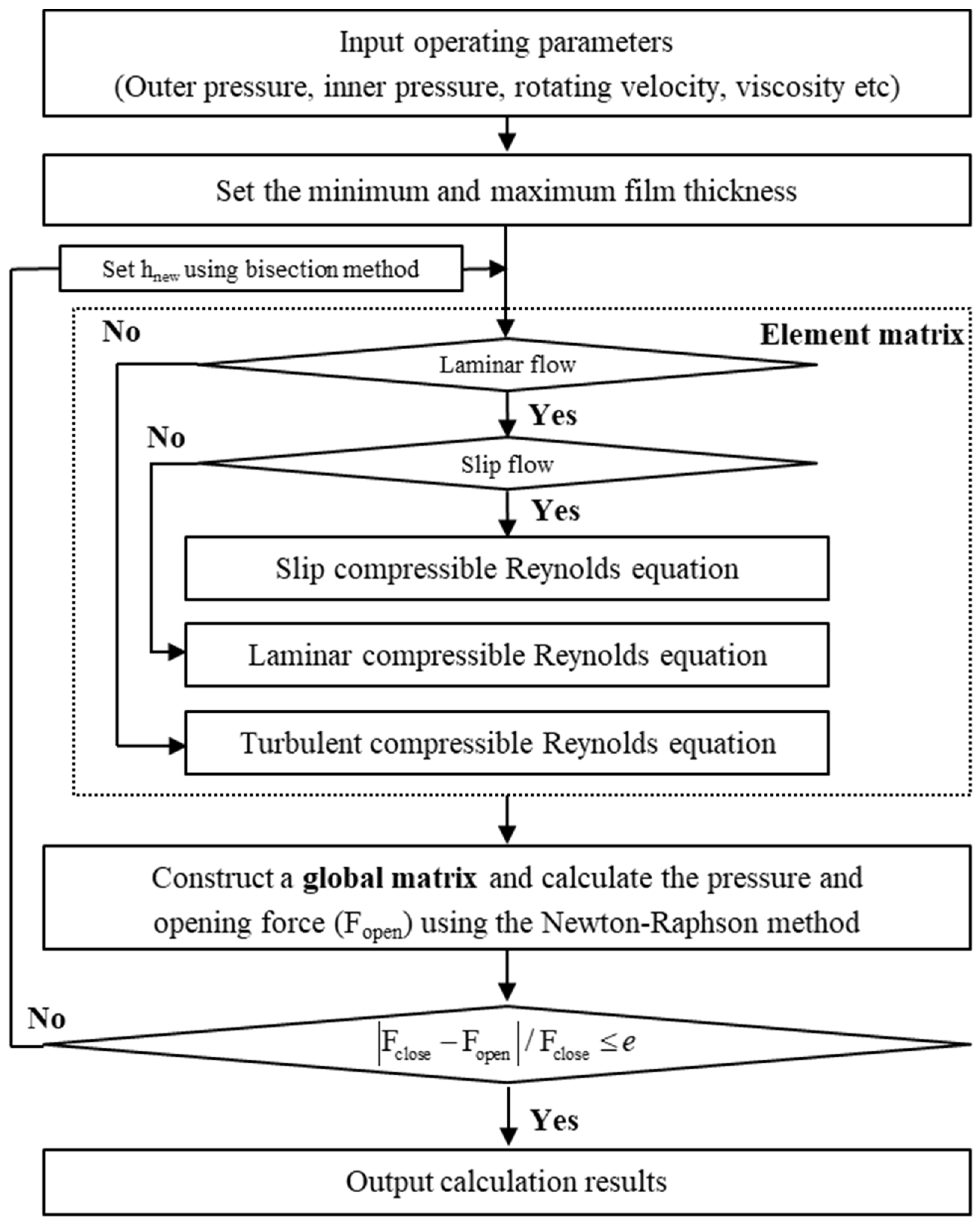
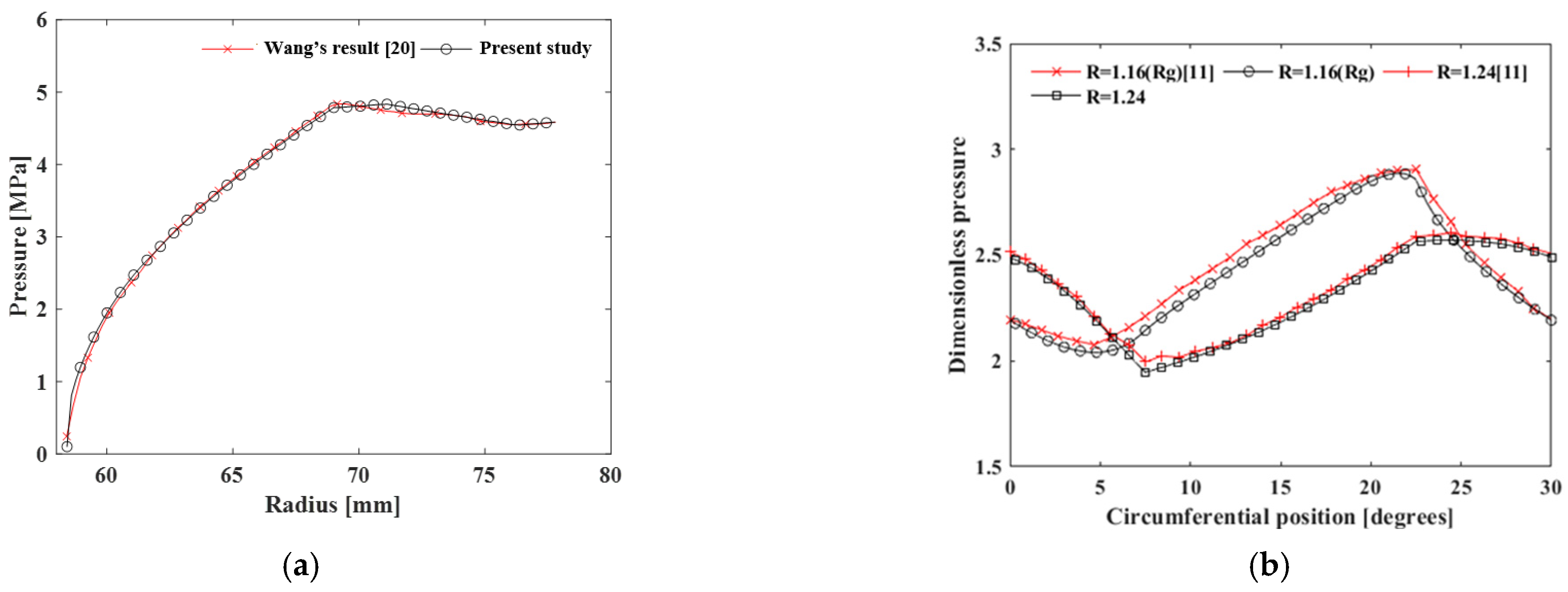
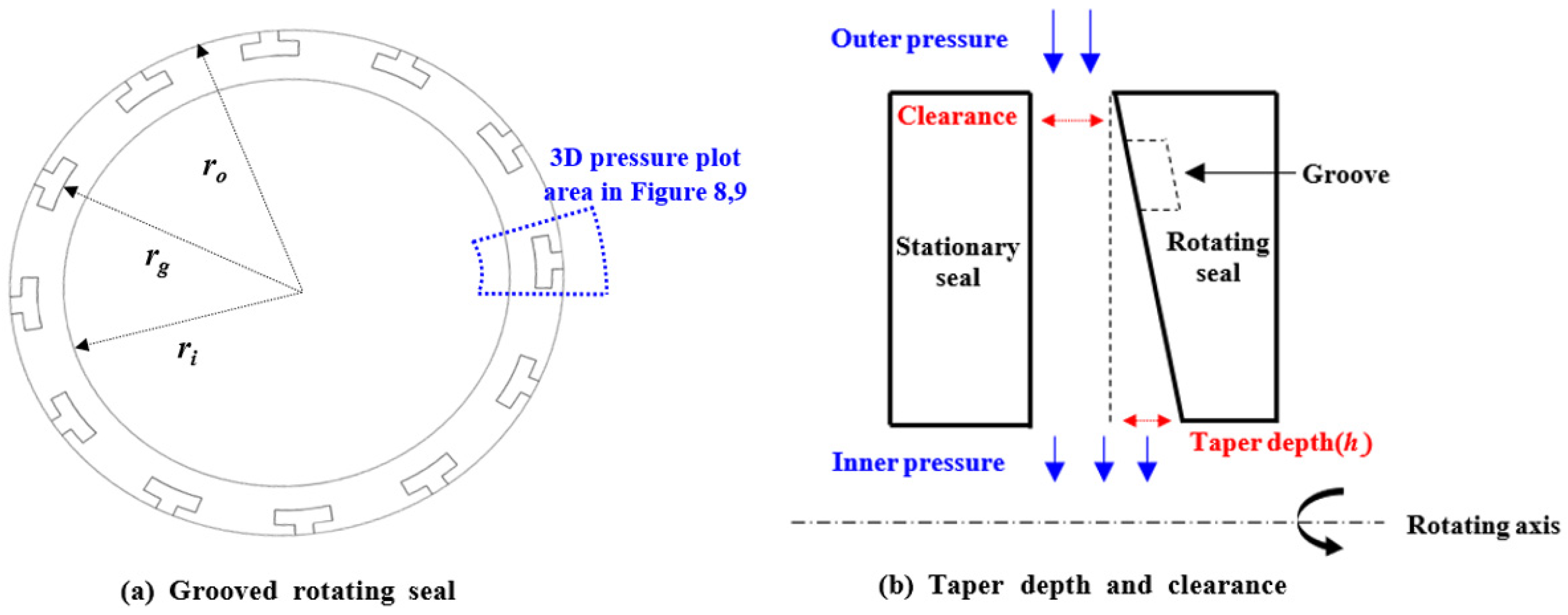
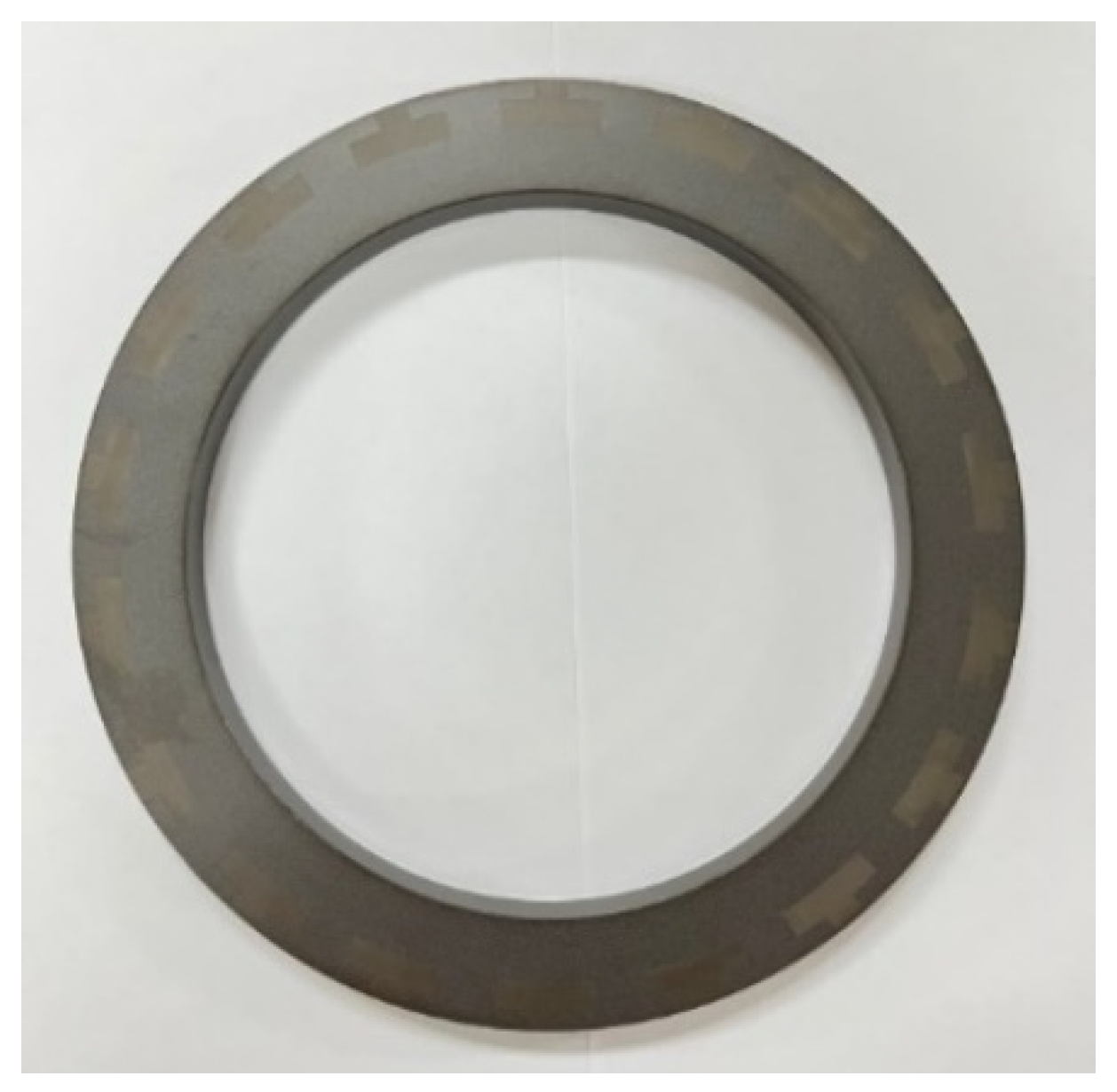
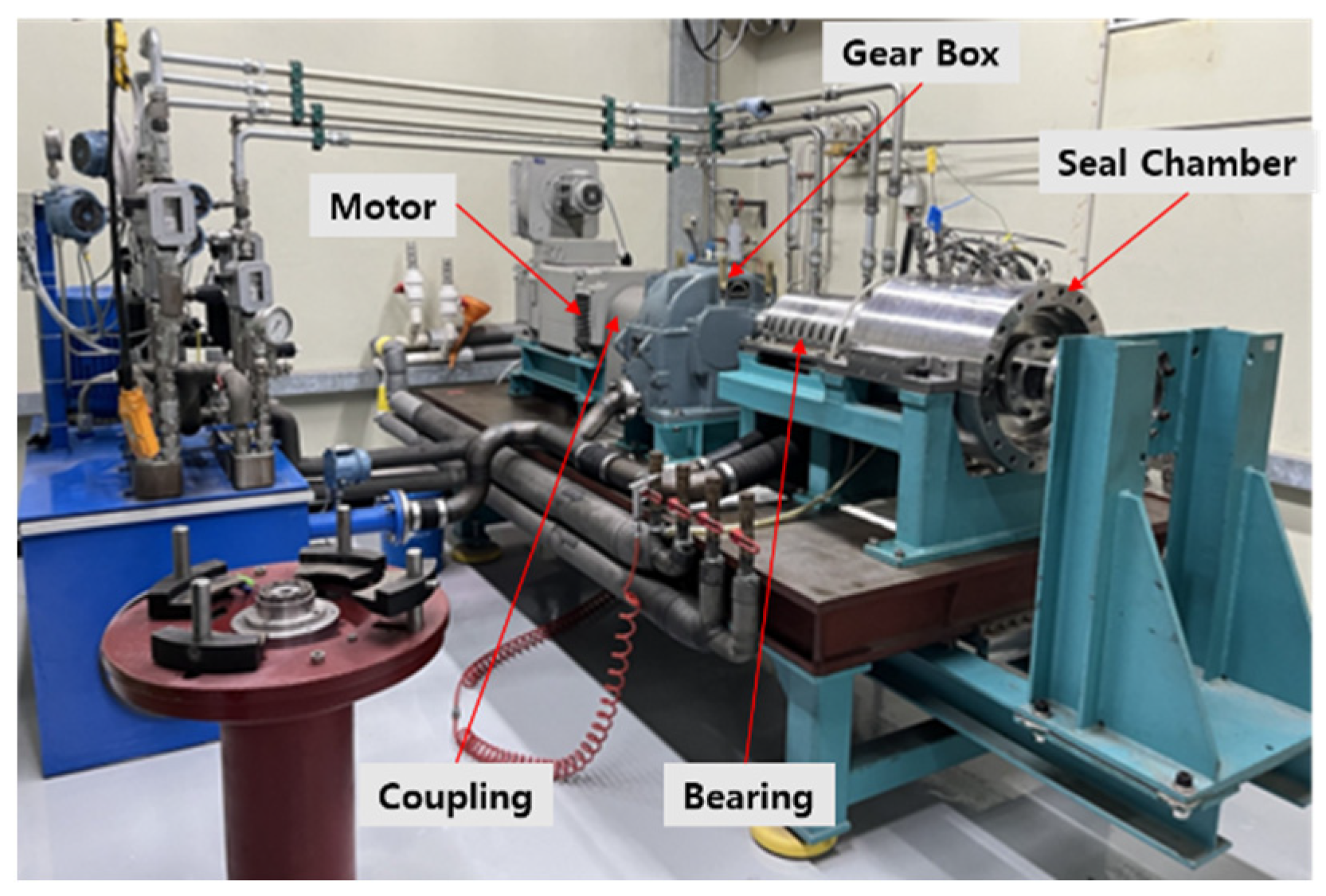
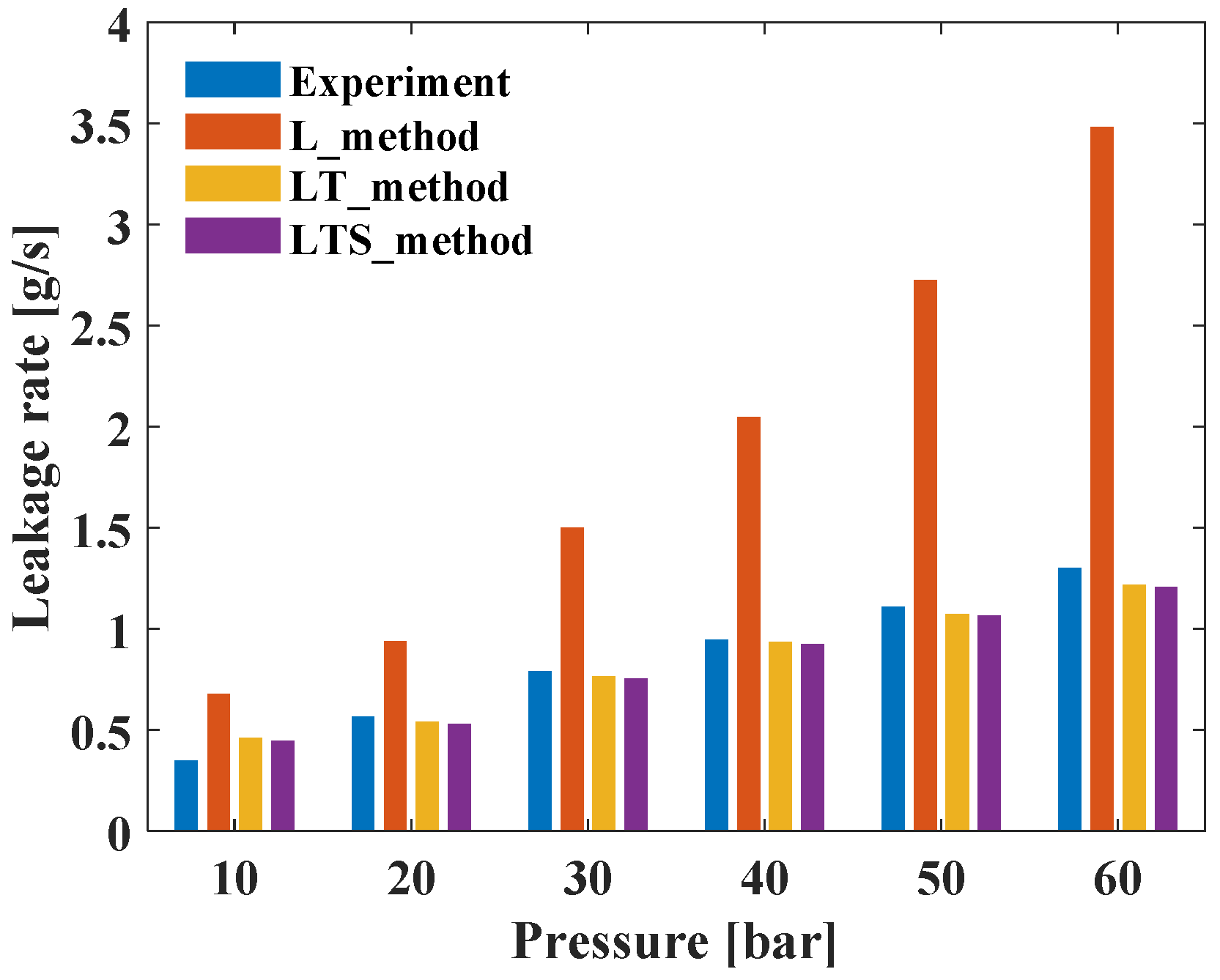
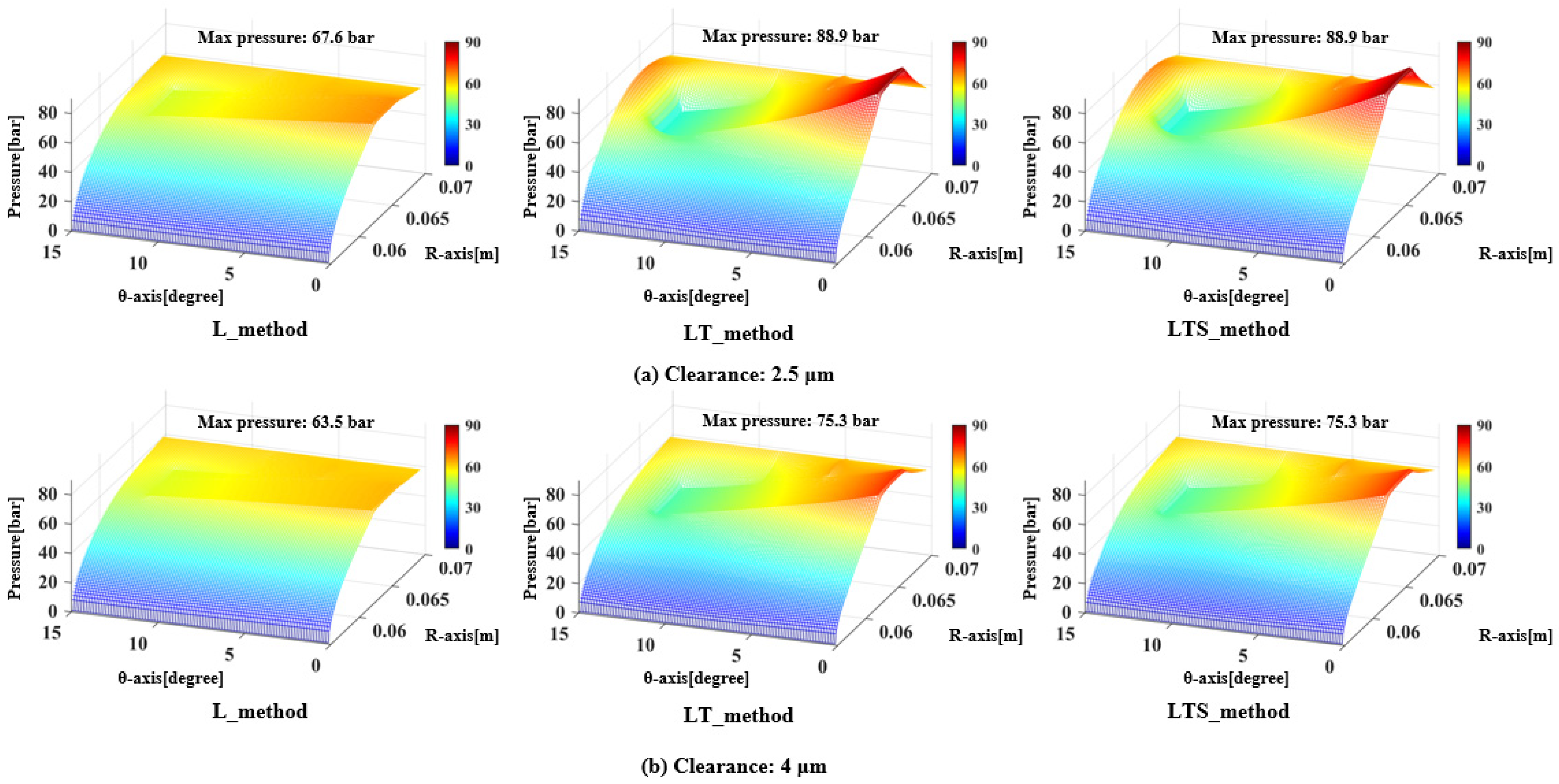
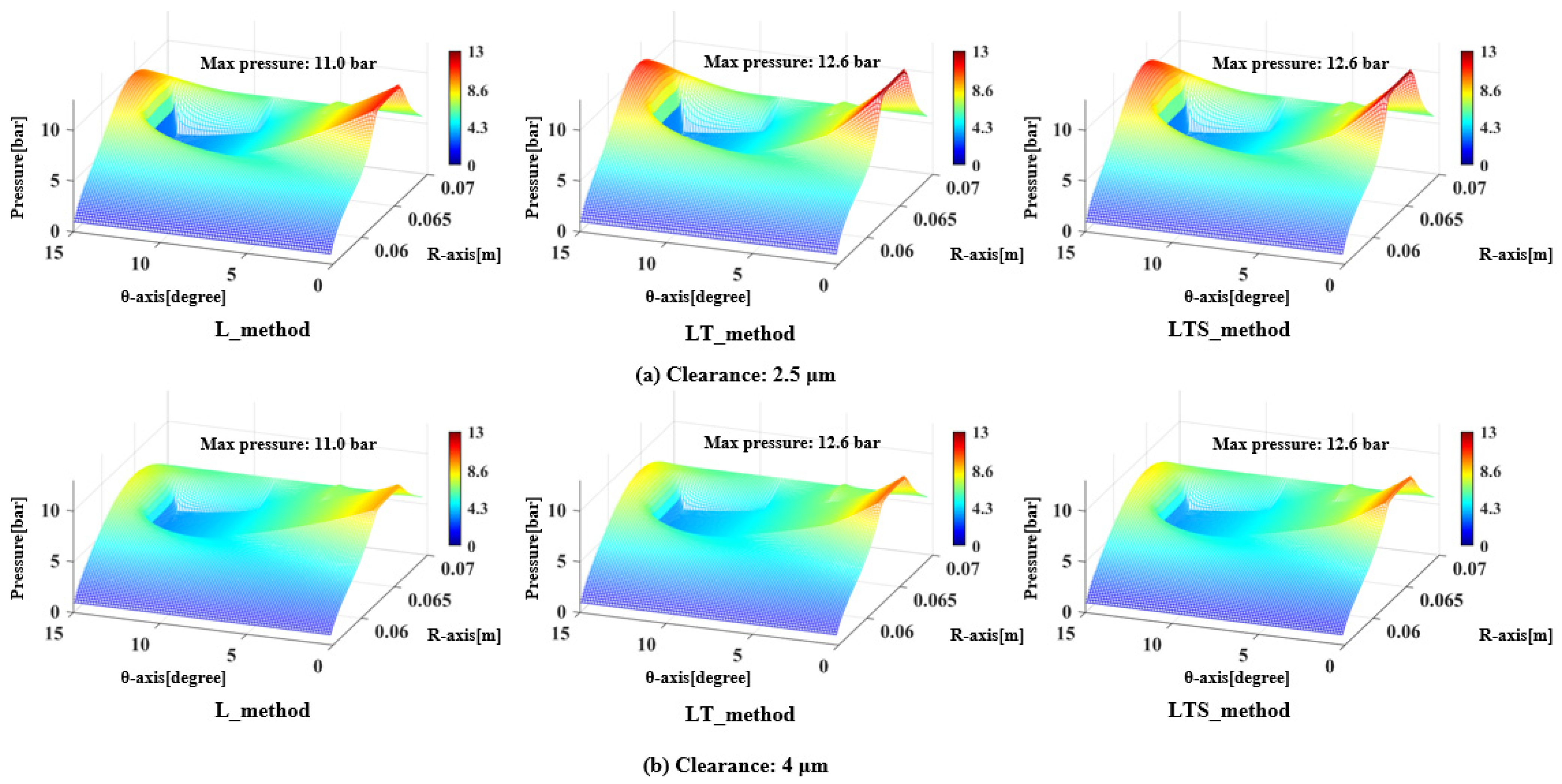

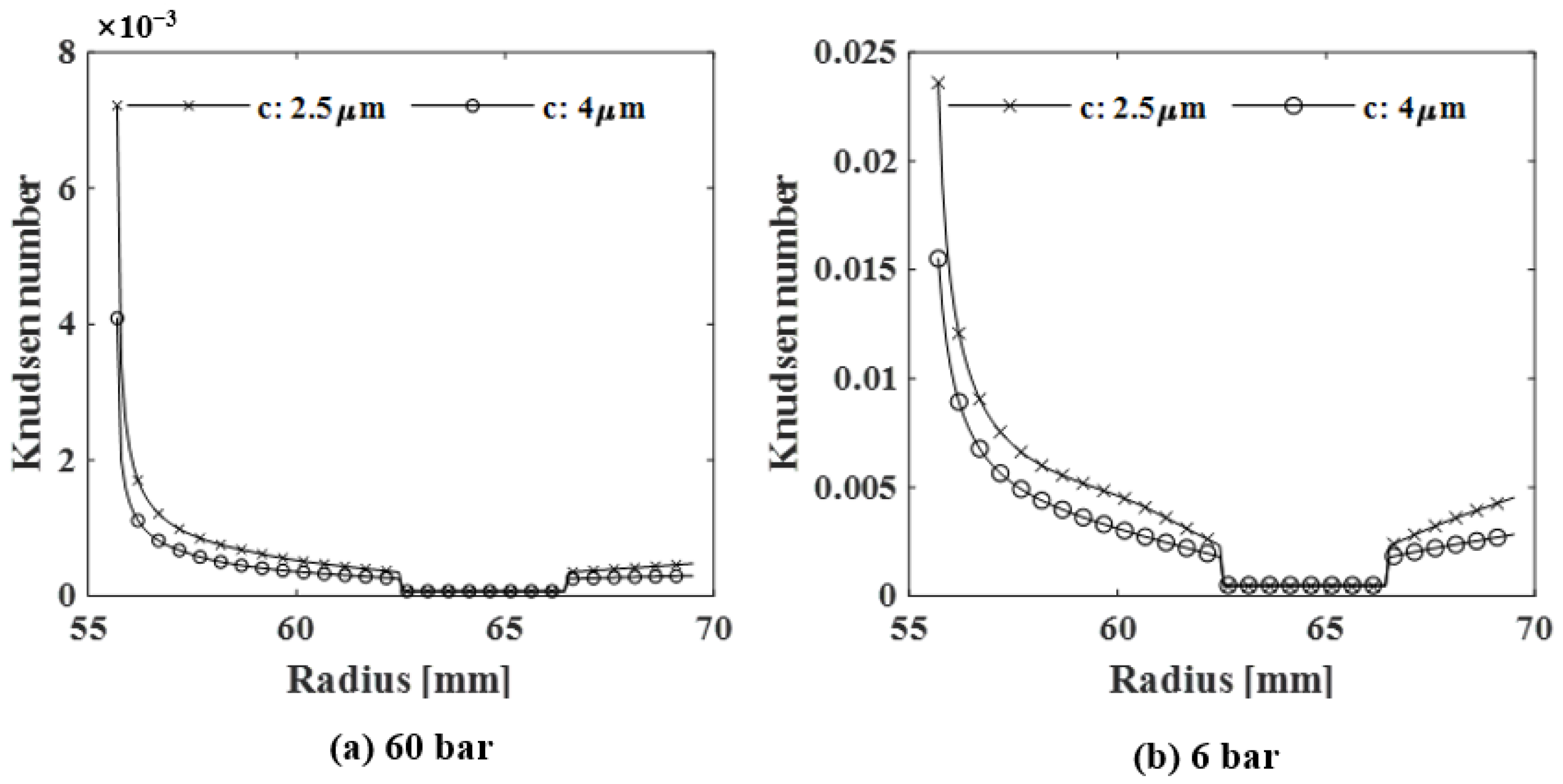
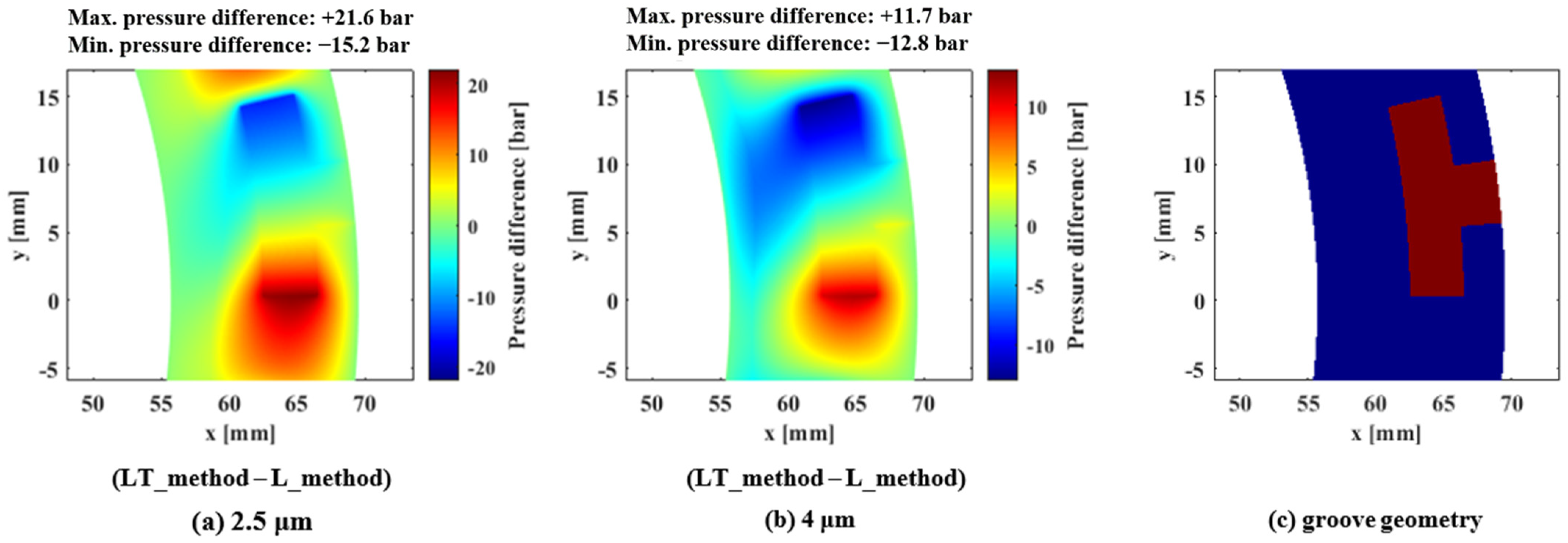
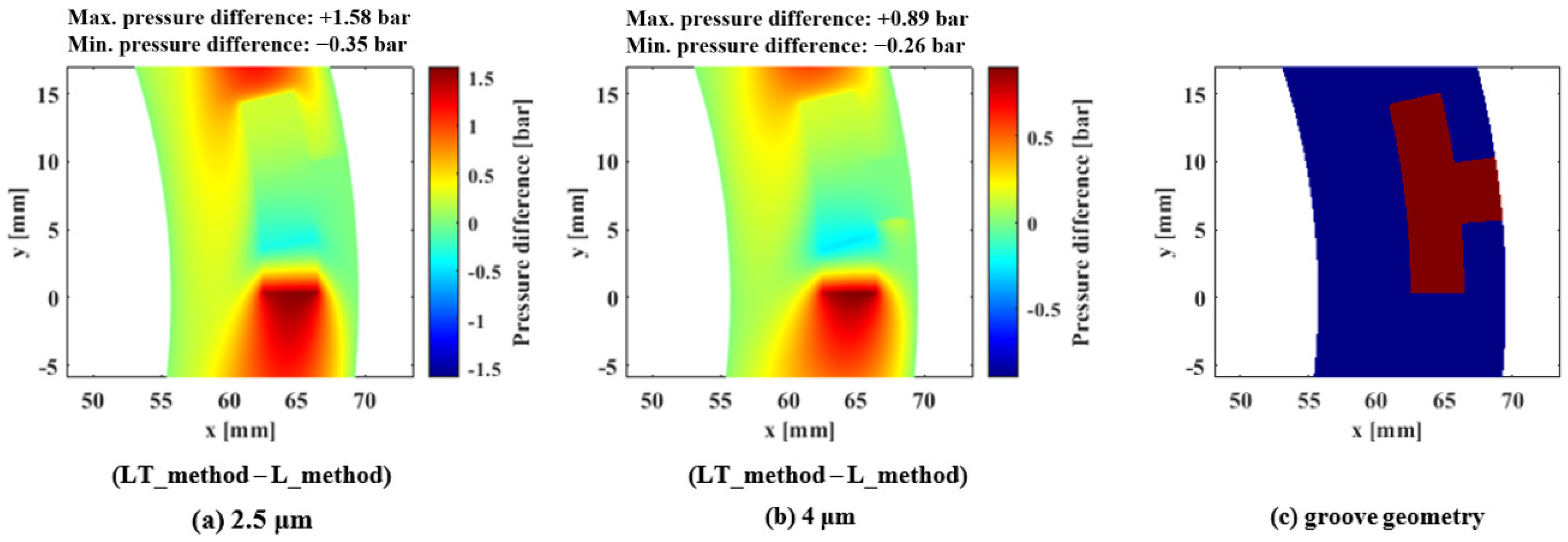
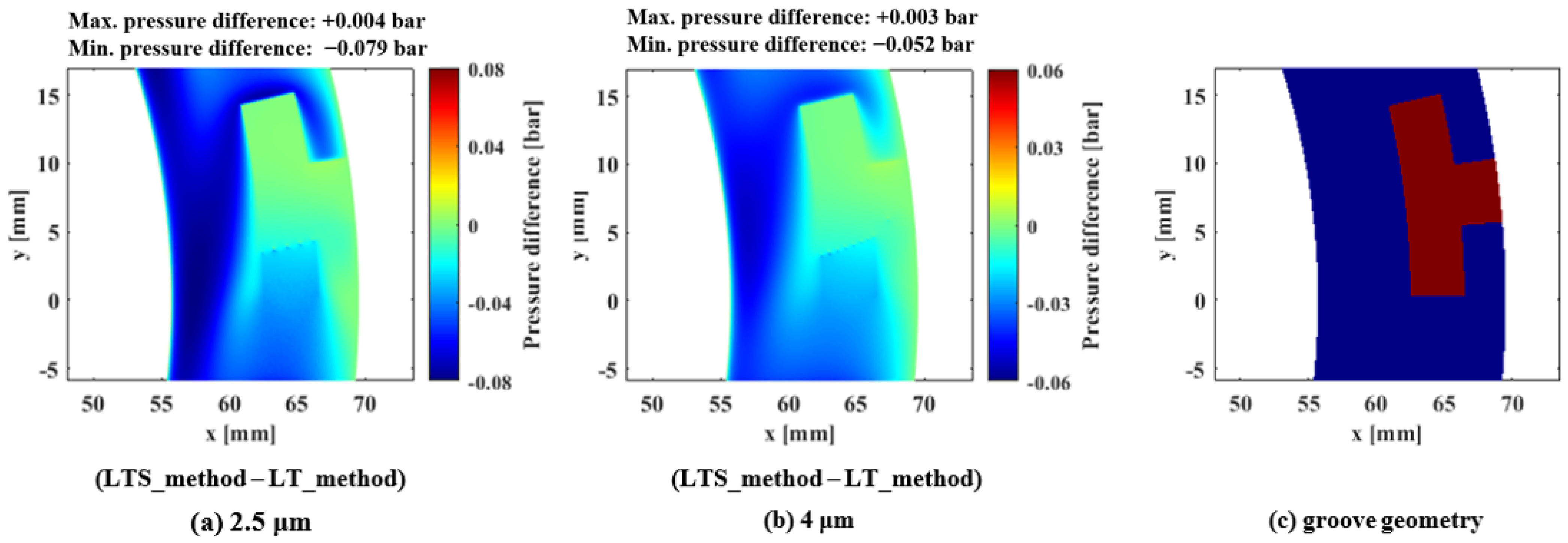
| Range of Inverse Kn | c0 | c1 | c2 | c3 |
|---|---|---|---|---|
| 5 < 1/Kn ≤ 1000 | 1.000 | 6.097 | 6.391 | −12.812 |
| 0.15 < 1/Kn ≤ 5 | 0.831 | 7.505 | 0.939 | −0.058 |
| 1/Kn ≤ 0.15 | −13.375 | 12.640 | 0.099 | 0.0004 |
| Fluid Condition | Cr | Cθ |
|---|---|---|
| Laminar | 1/12 | 1/12 |
| Turbulent | 1/Gr | 1/Gθ |
| Slip | qp/12 | qp/12 |
| Parameter | Value |
|---|---|
| Outer radius, ro [mm] | 69.5 |
| Groove radius, rg [mm] | 62.4 |
| Inner radius, ri [mm] | 55.7 |
| Groove number, ng | 12 |
| Groove depth, hg [mm] | 0.007 (average) |
| Taper depth, ht [mm] | 0.003 |
| Spring force [N] | 36 |
| Outer Pressure [bar] | Leakage Rate [g/s] | Difference [%] | |||||
|---|---|---|---|---|---|---|---|
| Experiment | L_Method | LT_Method | LTS_Method | Experiment − L_Method | Experiment − LT_Method | Experiment − LTS_Method | |
| 10 | 0.36 | 0.68 | 0.47 | 0.45 | −92.5 | −31.5 | −27.7 |
| 20 | 0.57 | 0.94 | 0.55 | 0.54 | −65.3 | 4.3 | 6.2 |
| 30 | 0.80 | 1.51 | 0.77 | 0.76 | −88.9 | 3.1 | 4.5 |
| 40 | 0.95 | 2.06 | 0.94 | 0.93 | −115.8 | 1.1 | 2.2 |
| 50 | 1.12 | 2.73 | 1.08 | 1.07 | −144.6 | 3.1 | 4.1 |
| 60 | 1.31 | 3.49 | 1.22 | 1.21 | −166.8 | 6.4 | 7.3 |
| Clearance [μm] | Opening Force [N] | Difference [%] | ||||
|---|---|---|---|---|---|---|
| L_Method | LT_Method | LTS_Method | L_Method − LT_Method | L_Method − LTS_Method | LT_Method − LTS_Method | |
| 2.5 | 27,372 | 28,462 | 28,432 | 4.0 | 3.9 | −0.1 |
| 3 | 27,152 | 27,477 | 27,451 | 1.2 | 1.1 | −0.1 |
| 3.5 | 26,948 | 26,704 | 26,681 | −0.9 | −1.0 | −0.1 |
| 4 | 26,758 | 26,087 | 26,067 | −2.5 | −2.6 | −0.1 |
| Clearance [μm] | Opening Force [N] | Difference [%] | ||||
|---|---|---|---|---|---|---|
| L_Method | LT_Method | LTS_Method | L_Method − LT_method | L_Method − LTS_Method | LT_Method − LTS_Method | |
| 2.5 | 3372 | 3564 | 3544 | 5.7 | 5.1 | −0.6 |
| 3 | 3231 | 3376 | 3358 | 4.5 | 3.9 | −0.5 |
| 3.5 | 3115 | 3228 | 3213 | 3.6 | 3.1 | −0.5 |
| 4 | 3017 | 3111 | 3098 | 3.1 | 2.7 | −0.4 |
| Clearance [μm] | Leakage Rate [mg/s] | Difference [%] | ||||
|---|---|---|---|---|---|---|
| L_Method | LT_Method | LTS_Method | L_Method − LT_Method | L_Method − LTS_Method | LT_Method − LTS_Method | |
| 2.5 | 458.4 | 381.3 | 384.3 | −16.8 | −16.2 | 0.8 |
| 3 | 963.0 | 761.3 | 764.7 | −20.9 | −20.6 | 0.4 |
| 3.5 | 1643.0 | 1230.3 | 1234.6 | −25.1 | −24.9 | 0.3 |
| 4 | 2527.4 | 1794.5 | 1800.6 | −29.0 | −28.8 | 0.3 |
| Clearance [μm] | Leakage Rate [mg/s] | Difference [%] | ||||
|---|---|---|---|---|---|---|
| L_Method | LT_Method | LTS_Method | L_Method − LT_Method | L_Method − LTS_Method | LT_Method − LTS_Method | |
| 2.5 | 11.1 | 12.6 | 13.0 | 12.7 | 16.1 | 3.0 |
| 3 | 15.5 | 17.1 | 17.5 | 10.5 | 12.9 | 2.2 |
| 3.5 | 22.0 | 23.9 | 24.3 | 8.8 | 10.7 | 1.7 |
| 4 | 30.7 | 33.0 | 33.5 | 7.6 | 9.1 | 1.5 |
Publisher’s Note: MDPI stays neutral with regard to jurisdictional claims in published maps and institutional affiliations. |
© 2022 by the authors. Licensee MDPI, Basel, Switzerland. This article is an open access article distributed under the terms and conditions of the Creative Commons Attribution (CC BY) license (https://creativecommons.org/licenses/by/4.0/).
Share and Cite
Hahn, M.; Park, Y.; Kang, M.; Jun, S.; Jang, G. Effects of Laminar, Turbulent, and Slip Conditions in a Fluid Film on a Dry Gas Seal. Machines 2022, 10, 954. https://doi.org/10.3390/machines10100954
Hahn M, Park Y, Kang M, Jun S, Jang G. Effects of Laminar, Turbulent, and Slip Conditions in a Fluid Film on a Dry Gas Seal. Machines. 2022; 10(10):954. https://doi.org/10.3390/machines10100954
Chicago/Turabian StyleHahn, Mibbeum, Youngjun Park, Minsoo Kang, Sanghyun Jun, and Gunhee Jang. 2022. "Effects of Laminar, Turbulent, and Slip Conditions in a Fluid Film on a Dry Gas Seal" Machines 10, no. 10: 954. https://doi.org/10.3390/machines10100954
APA StyleHahn, M., Park, Y., Kang, M., Jun, S., & Jang, G. (2022). Effects of Laminar, Turbulent, and Slip Conditions in a Fluid Film on a Dry Gas Seal. Machines, 10(10), 954. https://doi.org/10.3390/machines10100954







